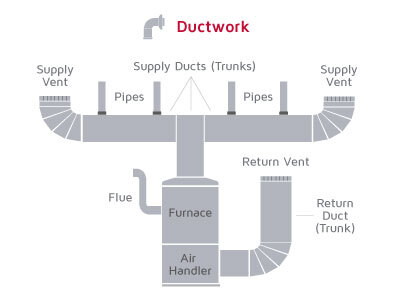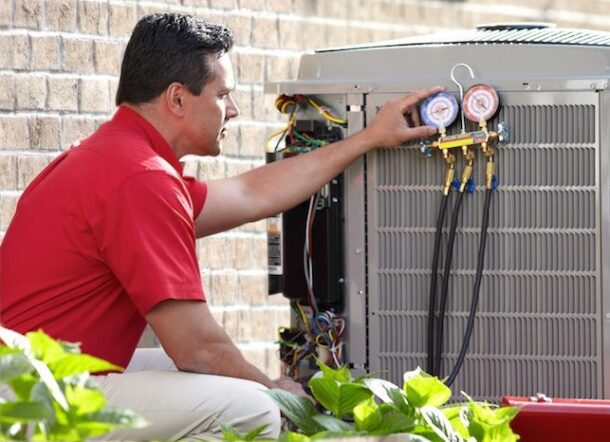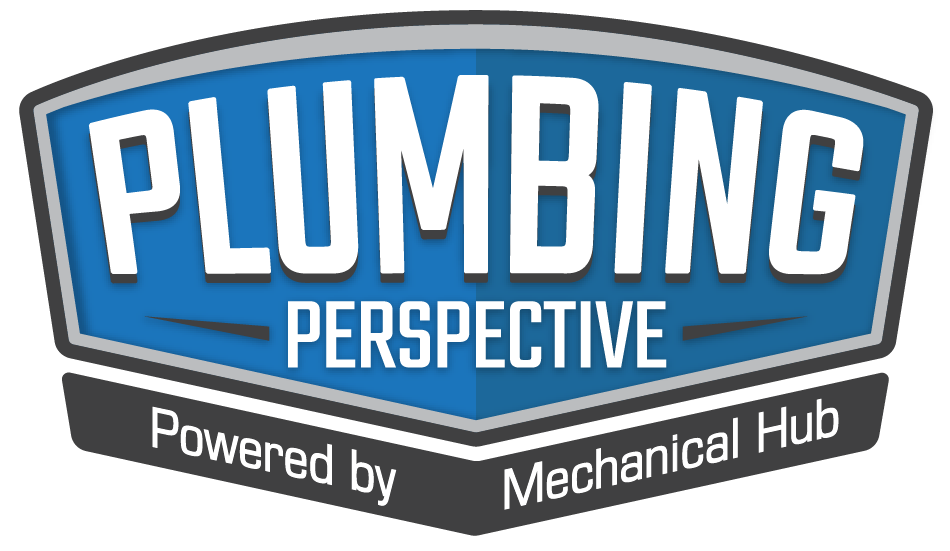Duct Systems Specifically: Why It’s a Different Ball GameFundamental Differences: What You Probably Already Know and What You Need to KnowCompatibility and Installation ConsiderationsConclusion: When to Use Which? The selection of duct system materials determines the success or failure of a project because it directly affects the structure. The general distinctions between polyvinyl chloride (PVC) Read more
plumbers

Table of Contents
The selection of duct system materials determines the success or failure of a project because it directly affects the structure. The general distinctions between polyvinyl chloride (PVC) and chlorinated polyvinyl chloride (CPVC) are familiar to most plumbers, yet ductwork applications require additional evaluation.
The performance of PVC and CPVC ducts under various conditions requires knowledge from plumbers who work with HVAC technicians or manage complete retrofit jobs to achieve safe, efficient, and code-compliant systems.
The article examines the essential technical distinctions between PVC and CPVC duct systems, focusing on aspects most relevant to field plumbers, including temperature resistance, chemical compatibility, ease of installation, and regulatory requirements.

Duct Systems Specifically: Why It’s a Different Ball Game
Ductwork isn’t just piping. The primary purpose of pipes is to transport water and waste, but ducts serve to distribute air and, occasionally, toxic fumes or hot exhaust. The design requirements for ductwork, including pressure and materials, differ significantly from those of standard plumbing applications.
According to Lennox, ductwork is “a system of channels used to distribute air throughout a building.” The work of plumbers requires them to handle components that need to be both lightweight and corrosion-resistant, particularly when working with exhaust in mechanical rooms and fume extraction in laboratories or industrial settings. Your responsibility will include duct connection and material maintenance throughout their entire operational period, even though you will not be responsible for constructing the whole HVAC system.
Fundamental Differences: What You Probably Already Know and What You Need to Know
Let’s get the basics out of the way. Most plumbers already know this, but here’s a refresher in the context of ductwork:
- Temperature Tolerance: PVC is rated up to 140°F, while CPVC can handle up to 200°F. If you’re dealing with warm exhaust or chemical fumes, that extra 60 degrees can be a dealbreaker.
- Chemical Resistance: Both are good, but CPVC outperforms PVC in terms of resistance to acids, bases, and corrosive gases.
- Strength & Sizing: Both come in standard duct sizes, but CPVC tends to be more rigid and stable under stress.
- Cost: CPVC is generally 25–40% more expensive than PVC. However, when a failure could result in system-wide contamination or code violations, it can pay off in the long run.
The process becomes difficult because plumbing and mechanical codes do not match. The International Residential Code (IRC) permits PVC ducts, but the Uniform Mechanical Code (UMC) bans their use in commercial buildings. CPVC passes both flame and chemical tests because of its superior ratings.
The legal status of building materials varies across different areas, so check local regulations at the city, county, and state levels. NSF 61, ASTM F441, and UL 94 V-0 ratings should be checked.
CPVC meets higher standards of fire and chemical safety, which makes it a safer choice for many duct applications. It also meets inspector requirements more effectively in high-risk or regulated environments, such as hospitals or laboratories, particularly when there is uncertainty.
Compatibility and Installation Considerations
Plumbers often overlook material compatibility checks, particularly when working with PVC or CPVC ducts that need to be connected to metals, or when using untested gaskets or sealants.
The connection of galvanized steel components to CPVC ducts through direct contact without an isolating gasket may lead to galvanic corrosion. The installation requires connectors and sealants, which are specifically designed for CPVC applications.
PVC cement does not function properly with CPVC materials. The solvent used for CPVC requires stronger properties and slower curing time.
Plumbers perform PVC cutting operations and gluing tasks. The installation process for CPVC follows the same steps as PVC but requires additional procedures:
- CPVC requires an extended curing period, which becomes more significant during cold weather conditions, thus affecting project schedules.
- The cutting process for both materials remains straightforward but CPVC requires more precise and cleaner cuts because it breaks easily.
- The use of fine-tooth blades, combined with support cuts, will prevent CPVC from cracking during the cutting process.
- Metal saw blades should be used with caution when working with plastics
In long duct runs, expansion and contraction can cause buckling or cracking.
- PVC expands about 3x more than CPVC over the same temperature rise.
- If you’re working in a facility with frequent temperature swings, CPVC offers better dimensional stability and less maintenance down the line.
CPVC generally earns higher marks for flame and smoke resistance. It typically meets UL 94 V-0 standards, which means it self-extinguishes quickly and produces less toxic smoke in a fire scenario.
This is especially important in:
- Healthcare facilities
- Schools
- Commercial kitchens
- Anywhere with life-safety code requirements
PVC, on the other hand, can produce thick black smoke and continues to burn once ignited.
While ductwork doesn’t usually carry fluid pressure, static pressure still matters—especially in exhaust or fume systems.
- PVC ductwork typically handles lower pressure (up to 10 inches of water column).
- CPVC ducts can manage slightly higher pressures, and with better rigidity, they resist collapse under vacuum.
For high-performance fume extraction or long vertical runs, CPVC has the edge.
Conclusion: When to Use Which?
Here’s the bottom line:
| Scenario | Recommended Material |
| Low-temp air movement | PVC duct |
| Chemical fume exhaust | CPVC duct |
| High-temp or steam ventilation | CPVC duct |
| Tight budget, low risk | PVC duct |
| Hospitals, labs, or code-heavy installations | CPCV duct |
| Jurisdictional uncertainty | CPVC duct |
Plumbers who perform HVAC installations or manage crossover systems should understand the distinction between PVC and CPVC ducts, as it represents essential knowledge for proper job execution. Knowledge of performance boundaries, installation characteristics, and regulatory standards for each material helps prevent both expensive callbacks and inspection failures, as well as system breakdowns in the future.
Your knowledge enables you to select appropriate ductwork with confidence while improving your collaboration with HVAC technicians and maintaining system integrity through all joints, runs, and transitions under both physical and actual pressure.

Author Bio: Mark Ligon is the marketing manager at Commercial Industrial Supply, a supplier of commercial & industrial piping, fittings, valves, filtration products, and accessories. Ligon enjoys educating businesses on the specific parts of piping systems so managers can make informed decisions.

New report reveals how small home service businesses are adapting to economic uncertainty through pricing strategies and digital payments New report reveals how small home service businesses are adapting to economic uncertainty through pricing strategies and digital paymentsKey Insights from the ReportSegment Highlights: Green, Cleaning, Contracting, and Construction Jobber, the leading provider of home service Read more
New report reveals how small home service businesses are adapting to economic uncertainty through pricing strategies and digital payments
Table of Contents
Jobber, the leading provider of home service software, today released its latest Home Service Economic Report: Q1 2025. The Q1 2025 edition combines Jobber’s proprietary platform data aggregated from more than 250,000 residential cleaners, landscapers, HVAC technicians, electricians, plumbers, and more, with external economic indicators to provide comprehensive insight into the trends shaping one of the fastest-growing and most essential parts of the small business economy, Home Service. The report is available at: https://getjobber.com/home-service-reports/may-2025/.
“The Home Service economy is showing encouraging signs of stabilization, even as some uncertainty remains,” said Sam Pillar, CEO and co-founder of Jobber. “Our data shows that demand for services is evolving. Homeowners are prioritizing essential services and value-driven investments, creating strong opportunities for businesses that stay agile, manage costs wisely, and continue to deliver exceptional work. There’s real potential ahead for those prepared to meet the moment.”

Key Insights from the Report
- Signs of stabilization amid uncertainty: While inflation cooled and household spending remained steady, elevated interest rates and cautious consumer sentiment continued to limit demand for large-scale, financed projects. As a result, homeowners shifted toward practical, value-oriented services.
- Digital payments hit record high: Digital payments accounted for 47% of all transactions in Q1, up from 43% a year prior, highlighting homeowners’ growing expectations for ease, speed, and professionalism in their service experience.
Segment Highlights: Green, Cleaning, Contracting, and Construction
Home Service businesses experienced mixed results in Q1 2025, with revenue stability driven by smaller, recurring jobs in segments like Green and Cleaning, while larger, discretionary projects in Contracting and Construction continued to face headwinds. A deeper breakdown is as follows:
- Green: Started the year strong, with an 8% year-over-year increase in new work scheduled in January. Bookings dipped mid-quarter, but revenue rose 6% year-over-year due to bundled services and modest price increases.
- Cleaning: New work scheduled fell 4% year-over-year, yet revenue held up thanks to a 5% increase in average invoice size, driven by upselling and recurring service models.
- Contracting: Demand for core repair and diagnostic services remained steady, but growth was flat. New work scheduled declined 4% year-over-year, and revenue saw a modest 1% gain.
- Construction: The segment saw an uptick in project planning with a 4% increase in new work scheduled, but revenue declined as many jobs appeared delayed or incomplete, reflecting cautious homeowner spending and seasonal slowdown.

“The Q1 data shows a sector in transition—stable, but still under pressure from high borrowing costs and cautious consumer behavior,” said Abheek Dhawan, Senior Vice President of Strategy & Analytics at Jobber. “We’re seeing nuanced shifts of essential services holding strong, while larger projects appear to lag. This kind of segmented, ground-level insight is critical for understanding where the market is heading and how businesses can plan for what’s next.”
To download the Jobber Home Service Economic Report: Q1 2025, visit: https://getjobber.com/home-service-reports/may-2025/.

New AI-powered solution adjusts advertising spend in real-time based on actual job availability for Scorpion & ServiceTitan clients Scorpion, the leading provider of digital marketing and technology solutions for local businesses, and ServiceTitan, a software platform that powers the trades, announced the launch of Capacity Marketing Engine, a new AI-powered product designed to help home Read more
New AI-powered solution adjusts advertising spend in real-time based on actual job availability for Scorpion & ServiceTitan clients

Scorpion, the leading provider of digital marketing and technology solutions for local businesses, and ServiceTitan, a software platform that powers the trades, announced the launch of Capacity Marketing Engine, a new AI-powered product designed to help home services providers maximize digital advertising spend, maintain a full schedule, and reduce unnecessary advertising costs. Capacity Marketing Engine is exclusively available to select Scorpion clients now and available for all clients who have purchased Scorpion’s RevenueMAX and ServiceTitan’s Marketing Pro with Ads Optimizer beginning in May.
Home services businesses—such as HVAC companies, plumbers, and electricians—rely on consistent lead generation to fuel growth. However, fluctuating demand, seasonal slowdowns, and the unpredictability of consumer needs can lead to inefficiencies in advertising spending and scheduling. As a result, home services businesses face wasted marketing dollars, missed revenue targets, idle technicians, and unsatisfied customers.
Scorpion’s Capacity Marketing Engine uses AI-powered automation to adjust advertising spend based on real-time business capacity information from ServiceTitan. When demand is low, the system automatically boosts advertising to fill the schedule; when capacity is high, spend is scaled back to avoid overallocation.
With Capacity Marketing Engine, the connection between scheduling and demand fluctuations is now aligned and intuitively directs the advertising strategy for a true ‘smart scheduler.’ Now, home services businesses can redirect their focus to what matters: delivering exceptional service, helping to maximize ROI, and hitting revenue goals.
This launch deepens the strategic partnership between Scorpion and ServiceTitan, combining advanced advertising automation with business data from the industry’s most trusted field service platform. Together, they’re setting a new standard for how home services businesses grow: smarter, faster, and with greater efficiency than ever before.
“For business owners, Capacity Marketing Engine enables investment decisions that directly support profitability and long-term growth,” said Rustin Kretz, Founder and CEO of Scorpion. “We’re proud to launch this with our partners at ServiceTitan—it’s another step toward helping our clients grow more efficiently, stay fully booked, and maximize their revenue.”
Key Benefits of Capacity Marketing Engine:
- Automated Advertising Spend Adjustment: AI-powered technology that increases spend during slower periods and scales back when schedules are full.
- Real-Time Visibility and Control: Built-in transparency through Scorpion’s Revenue App provides a clear, historical log of budget changes and the triggers behind them—so clients always know what’s happening and why.
- Time and Cost Savings: Reduced need for manual ad management, freeing business owners to focus on service delivery.
- Enhanced Marketing Efficiency: Optimized marketing budgets to help generate maximum return on investment and drive consistent growth.
To learn more about Capacity Marketing Engine and how Scorpion and ServiceTitan are transforming growth for home services businesses, visit scorpion.co/capacity-marketing.

https://vimeo.com/1053954636 This Weekly Update is powered by our partners at Milwaukee Tool. Did you know that five United Association of Union Plumbers and Pipefitters (UA) members were on that fateful flight in which a passenger jet collided with a military helicopter midair? They are: Jesse Pitcher, UA Local 5; Charlie McDaniel, UA Local 602; Jonathan D. Boyd, UA Read more
This Weekly Update is powered by our partners at Milwaukee Tool.
Did you know that five United Association of Union Plumbers and Pipefitters (UA) members were on that fateful flight in which a passenger jet collided with a military helicopter midair?
They are: Jesse Pitcher, UA Local 5; Charlie McDaniel, UA Local 602; Jonathan D. Boyd, UA Local 602; Mikey Stovall, UA Local 602; and Alex Huffman, UA Local 602. May their souls rest in peace.
Also on this update:
A Path to Electrification
Podcasts
MTGA: Solar, HVAC and Boiler talk oh my!
AFC: AI & Plumbing with Susan Frew and John Mullen

Home Service businesses to benefit from focus on maintenance projects as homeowners regain financial flexibility Jobber, the leading provider of home service software, today released its latest Home Service Economic Report: 2024 Q3. The report features expert insights and proprietary data aggregated from more than 250,000 residential cleaners, landscapers, HVAC technicians, electricians, plumbers, and more, who Read more
Home Service businesses to benefit from focus on maintenance projects as homeowners regain financial flexibility
Jobber, the leading provider of home service software, today released its latest Home Service Economic Report: 2024 Q3. The report features expert insights and proprietary data aggregated from more than 250,000 residential cleaners, landscapers, HVAC technicians, electricians, plumbers, and more, who run their businesses using Jobber.
The U.S. Federal Reserve’s recent interest rate cuts are already showing early signs of impact on consumer spending, bringing cautious optimism for the home service industry. After a slower first half of 2024, Jobber’s data shows increased momentum through the end of Q3, signaling a gradual recovery fueled by improved financial flexibility for consumers. These findings are also supported by the Michigan Consumer Sentiment Index (MCSI), a monthly survey based on interviews that measure U.S. consumer attitudes towards personal finances, business conditions and economic activity.

“As we move through the second half of 2024, we’re seeing encouraging signs for the home service category—especially as financial conditions continue to improve and consumer confidence grows,” said Sam Pillar, CEO & co-founder of Jobber. “At Jobber, we’re committed to helping small home service businesses capitalize on these opportunities, and the data we’re seeing suggests a path toward sustained growth in the months and years ahead.”
Demand for Home Service Outpaces Consumer Goods
Despite fluctuations in new work volume, consumer demand for home services held steady in Q3, with spending on services outpacing consumer goods. Higher average invoice sizes helped stabilize revenue, balancing the variability in new work. As interest rate cuts improve disposable income and consumer sentiment, household spending power is expected to rise, potentially driving further growth in home service demand.
Economists anticipate that the interest rate cuts will continue into 2025, providing greater affordability in areas like mortgage rates and financing for home improvements. This environment is expected to boost activity across both the housing and home service markets as consumers look to invest in essential home maintenance and renovation projects.
The housing market remains closely tied to demand for home services, and recent data indicates a promising future for this sector. While certain indicators, such as construction spending, new permits, and housing starts, have shown temporary stagnation, the cumulative effect of rate cuts is projected to revitalize the market by mid-2025. Rising home equity and expected increases in home improvements will drive demand for both discretionary and essential projects, pushing projected annual spending to $477 billion by Q3 2025, nearing previous peak levels.
Jobber’s report includes insights on the four key segments within the home services category, revealing trends in consumer spending and business resilience:
- Green: The Green segment, which includes lawn care and landscaping, saw early growth in 2024, though activity slowed in Q3 except for July. Despite economic pressures, median revenue remained stable as homeowners prioritized smaller, recurring outdoor maintenance over large renovations.
- Cleaning: Cleaning services, including residential and commercial cleaning, have seen rising median prices but declining volumes in 2024. While new work scheduled fluctuated due to reduced consumer spending, service providers have maintained stable revenue growth by increasing prices and focusing on premium offerings.
- Contracting: The Contracting segment, covering services like electricians and HVAC, experienced a downturn in new work scheduled by late Q3. Nonetheless, median revenue stayed steady, likely due to pricing adjustments and a shift toward higher-value projects.
- Construction: Construction services, including residential and commercial projects, have seen an improvement in median revenue as consumer spending shifts toward maintenance and improvements. However, new work scheduled continued to decline in Q3, reflecting cautious spending amid the gradual economic recovery.
“The 2024 Q3 Jobber Home Service Economic Report shows a promising outlook for the home services sector as interest rate cuts start to boost consumer spending and demand,” said Abheek Dhawan, Senior VP, Strategy & Analytics at Jobber. “With rising home equity and a shift toward maintenance projects, we anticipate steady growth as financial conditions improve. The sector is well-positioned to benefit from an aging housing stock and increased focus on essential updates, setting the stage for sustained demand and expansion through 2025 and beyond.”
To download the Jobber Home Service Economic Report: 2024 Q3, visit: https://getjobber.com/home-service-reports/nov-2024/
